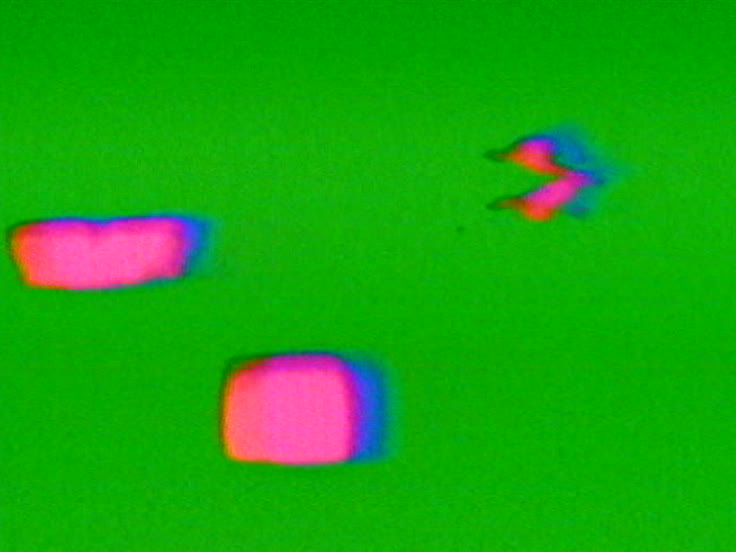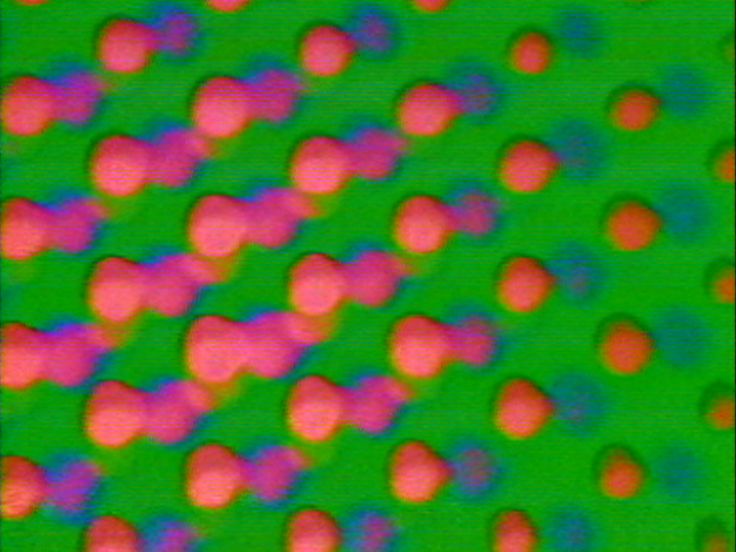title
Moiré
artist
Livinus van de Bundt & Jeep van de Bundt
intro
Colourful, abstract video paintings by Livinus are accompanied by the electronic music of his son Jeep. The visuals and the music are based on the same rhythmic processes and express a shared identity. Blue blocks with red borders are seen against a green background. Starting at the right top corner they begin to pulverize. Then they recover, form a grid, assume a zig zag pattern, and take on new colors. These waves of multiplying, transforming, and sliding visual elements act in synchronicity to the musical beat; they are causally bound. At an early stage of his career, Livinus built an image synthesizer and an image generator in order to achieve these effects. For this reason, the work is a forerunner of Dutch video art history.
biography artist
Livinus van de Bundt (1909 - 1979, commonly known as ‘Livinus’) is a key figure in the history of media art in the Netherlands, known for his medium specific videoworks and experiments. His so-called ‘video peintures’ and ‘fotografiek’ are the first abstract images that were made by a Dutch artist using video technology.
Livinus’s overall oeuvre reveals a profound curiosity and exploratory interest into different techniques and media. He has never been part of any artistic movement or restricted himself to one discipline within the arts. However, one can find his fascination with light running like a thread through his work.
Trained as a painter and a graphic artist, Livinus lived in Paris in the 1930s where he studied for a year at Atelier 17. At this graphic atelier, under the direction of Bill Hayter, printmaking was considered to be an artistic method in itself, instead of being merely a means for reproduction. Here, Livinus became acquainted with surrealism and was inspired by the ateliers’ praxis of experimenting with new techniques. Years later, in 1957, an exhibition of his graphic work took place at the Stedelijk Museum Amsterdam. Various reviews of the show mention the influence of surrealism and Picasso in the displayed works, which may stem back from his time in Paris as a young man before the war.
After the war, Livinus developed into an avant-garde artist. He started to work with abstract photography and slide projections, and explored methods that allowed him to shape light in different ways. He experimented with a self-created photographic procedure, which he called ‘photopeinture’: instead of a paintbrush Livinus used a glass fibre rod. He discovered that he could use the rod as a means to capture and transfer light beams onto a light-sensitive surface. In 1964, he won the Sikkens prize for his light paintings.
Inspired by Nam June Paik, Livinus started experimenting with video in 1970—aiming at ways to combine video with sound. Since his son Jeep was a musician who experimented with sound, they started to experiment together; thereby giving rise to the first generation of Dutch video artists.
In addition to his artistic practice, Livinus founded an art school in The Hague, the Free Academy of Visual Art, and remained artistic director until 1964. Inspired by the ideology of Maria Montessori, the academy was known for its open approach. The academy existed for 68 years, closing in 2015.
Livinus’ son Jeep (b. 1951) studied at the Royal Conservatory of Music in the Netherlands. Between 1967 and 1978 he played and recorded with several bands, playing drums and percussion. As a graphic artist he exhibited his work worldwide in the 1980s. Jeep now lives in Fort Lauderdale, Florida, where he collects and sells collector cars at the “Vanderbundt Collection”.
keywords
light, sound, music, electronics , video, MonteVideo, medium specific
images
[caption id="attachment_1038" align="alignnone" width="736"] Livinus & Jeep van de Bundt, Moiré, 1975, 6'12''.[/caption]
[caption id="attachment_1033" align="alignnone" width="736"]
Livinus & Jeep van de Bundt, Moiré, 1975, 6'12''.[/caption]
[caption id="attachment_1033" align="alignnone" width="736"] Livinus & Jeep van de Bundt, Moiré, 1975, 6'12''.[/caption]
Livinus & Jeep van de Bundt, Moiré, 1975, 6'12''.[/caption]
 Livinus & Jeep van de Bundt, Moiré, 1975, 6'12''.[/caption]
[caption id="attachment_1033" align="alignnone" width="736"]
Livinus & Jeep van de Bundt, Moiré, 1975, 6'12''.[/caption]
[caption id="attachment_1033" align="alignnone" width="736"] Livinus & Jeep van de Bundt, Moiré, 1975, 6'12''.[/caption]
Livinus & Jeep van de Bundt, Moiré, 1975, 6'12''.[/caption]
year
1970-1975
premiere
On February 25, 1978 the work was part of the opening exhibition of the MonteVideo gallery in Amsterdam.
software
functionality
Moiré is a video that displays colourful abstract visuals that move synchronously with the sounds of a melodic electronic soundtrack. The video can be projected, or played on a monitor.
part of collection
LIMA Amsterdam (previously MonteVideo, Montevideo/Time Based Arts, NIMk)
production
The creation process of Moiré, as well as some other works by Livinus, remains somewhat mysterious.
The interplay of sound and image in the video was attained by using a primitive video synthesizer, a machine that Livinus and Jeep built together. This so-called “Lumodinamiese Masjiene” (lumodynamic machine) consisted of lenses, lamps, and electronics, that were controlled by a keyboard. However, the exact construction of the machine—as well as other machines Livinus developed, either with or without his son Jeep—was kept secret.
Livinus made various installations that were built in a large metal closet with transparent material on the front, which displayed moving, abstract images. These closets were tightly sealed, to protect the secret construction from the outside eye. The images were recorded from a CRT monitor by using an open-reel tape recorder, which allowed for a high colour saturation. René Coelho transferred these open reels to U-Matic tapes. These tapes were preserved in the first video art preservation project, in which the content of the tapes was transferred to Betacam SP tapes. Various tape formats and files that contain the work are in the collection of LIMA.
hardware
Via a primitive video synthesizer, a lumodynamic machine, color and form react to sound.
technical specs
In addition to analogue tapes that were created for presentations over the years, the work has been digitized and is distributed by LIMA.
intention artistquote by artist
quote
“… there is an incredible range of possibilities. I wish the visual arts would start taking advantage of them all, because they will finally lead to a change in mentality, to a greater critical awareness; a change that in the end will turn away from the destructive and focus on the constructive and creative … if not, there will be no survival …”1
“Not only did LIVINUS see video as an efficient means to rework light and sound, but he also thought that the creative use of video would encourage his public to take a more critical stance towards the junk info on television and consequently inspire a new desire towards harmony.” (Rajandream, Marie-Ad è le. “Livinus and the Light” In: Mediamatic Magazine vol. 0#0, December 1, 1985. p. 15)
“Video graphics - the ultimate pictorial art” (source: li-ma.nl)
influence
An entire generation of artists have been influenced by the work and ideas of Livinus.
For René Coelho, Livinus’ work was the direct motivation to start his video art gallery MonteVideo in 1978 in Amsterdam, the future Amsterdam Centre for Media Art Montevideo, which later became the Netherlands Media Art Institute. Coelho studied photography at the Vrije Academie in The Hague in the 1960s, at the time when Livinus was the academy’s director.
In 1978, Coelho visited Livinus’ house and studio in Rijswijk, where he, together with his son Jeep, experimented with some ‘primitive’ equipment that, according to Coelho, “was tied together by rubber bands and paperclips” at times.2 Coelho was intrigued by these experiences with the first abstract video works in the Netherlands.
Livinus was influenced by Surrealism, Picasso, Bauhaus, Constructivism, and Expressionism (“die Brucke”). Together with Gerrit Rietveld, he was set to redesign the lighting of the Amersfoort theater, however Rietveld died before this project could be started.
context
1995:
“In Hommage aan Livinus van de Bundt in Pulchri Studio in Den Haag brengen veertien kunstenaars een eerbetoon aan deze pionier op het gebied van de kinetische- en mediakunst. Daarnaast een expositie van het werk van Livinus (1909 - 1979), bijeengebracht door het instituut voor mediakunst MonteVideo.”3
LITERATURE
"Sikkensprijs." SikkensFoundation. sikkensfoundation.org.
Internet Archive. web.archive.org.
Boomgaard, Jeroen, et al. De Magnetische Tijd: Videokunst in Nederland 1970-1985. nai010 Publishers, 2003.
Luijters, Rudy. Een Kleine Geschiedenis Van Een Medium/ Brief History of a Medium. MonteVideo/TBA, 1978.
Perrée, Rob. Into Video Art: the Characteristics of a Medium / De Karakteristieken Van Een Medium. Idea Books, 1988.
Rajandream, Marie-Adèle. “Livinus En Het Licht.” Dissertation. University of Leiden, 1986.
Rajandream, Marie-Adèle. "Livinus En Het Licht." Mediamatic Magazine, Nulnummer. vol.0, no.0, 1985. mediamatic.net.
part of active discussion
scene artists institutes
Vrije Academie The Hague, Gemak The Hague, MonteVideo/NIMk/LIMA Amsterdam
footnote
1 This quote by Livinus was hanging on a glass wall at the Gemak office, the former Vrije Academie Den Haag. Source: “History.” Vrije Academie, gemak.org.
2 Coelho, René. “(Re) Moiré (1975).” Received by Mila Van der Weide, (Re) Moiré (1975), 11 Nov. 2018. 3 “BEELDENDE KUNST.” De Volkskrant, De Volkskrant, 1 June 1995, volkskrant.nl.
Annie Abrahams
Livinus van de Bundt & Jeep van de Bundt
Driessens & Verstappen (Erwin Driessens and Maria Verstappen)
Yvonne le Grand
Edward Ihnatowicz
JODI (Joan Heemskerk & Dirk Paesmans)
Bas van Koolwijk
Lancel/Maat (Karen Lancel and Hermen Maat)
Jan Robert Leegte
Peter Luining
Martine Neddam
Marnix de Nijs and Edwin van der Heide
Dick Raaijmakers
Joost Rekveld
Remko Scha
Jeffrey Shaw
Debra Solomon
Steina
Peter Struycken
Michel Waisvisz